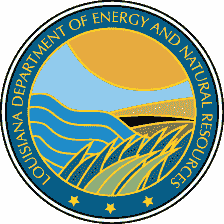Office of Coastal Management
DNR GEARS UP FOR NEW APPROACH TO MARSH GROWTH
A major innovative marsh vegetation program aimed at coastal renewal will engage state and federal agencies for the next five years. Department of Natural Resources (DNR) Secretary Jack Caldwell says DNR has signed interrelated interagency agreements with federal agencies and state universities to implement its multi-tasked Biomass Production Program at a projected cost of $641,888.
Work under the Biomass Production contracts will test the hypothesis that under proper circumstances, marsh vegetation can be made to grow faster than the coast subsides. The following is a summary of the program objectives:
- The National Wetland Research Center (an arm of the U. S. Geological Survey) will identify and develop new types of marsh plants with exceptional growth characteristics for rapid generation of new marsh areas.
- The Natural Resources Conservation Service (NRCS, a federal partner) will develop experimental and field studies to test initial plant research results, especially in dredge fill areas.
- Louisiana State University Wetland Biochemistry Institute will study vegetation in the Caernarvon outfall area, where new marsh growth is vigorously expanding, to analyze what nutrient, sediment and water combinations cause the growth.
- University of Southwestern Louisiana will analyze the sediment, nutrient and water flow environment in the Caernarvon outfall area to better understand affects on biomass production. This information will be used in design and planning of future freshwater diversions, and in operation of existing diversions.
The agencies and universities will cooperate and interact within their respective areas of expertise. Caldwell calls the scientists his "vegetarians".
DNR's Coastal Restoration division has for years promoted the use of marsh vegetation on coastal restoration projects. In the late 1980's, various types of marsh plants were hand dug and placed in targeted coastal locations to combat erosion. Since that time, more than 297 miles of marsh vegetation and 614 acres of coastal marsh have been planted. Today there are six Louisiana marsh vegetation growers who supply native plants for coastal restoration projects.
Caldwell thanked state legislators for early funding approval for the program in order to meet the spring planting season. He noted that he and DNR coastal specialists believe that faster biomass production could be a key in compensating for subsidence in coastal areas. He said that accelerating marsh growth and promoting "vertical accretion" will mean better habitats for our wildlife and fisheries. "I believe that with these studies Louisiana will continue to be the world leader in innovative development of marsh vegetation science for coastal restoration."
Editors: For additional information on this news item, please contact DNR's Coastal Restoration division, Project Manager Kenneth Bahlinger at (504) 342-7362.
News Archives »